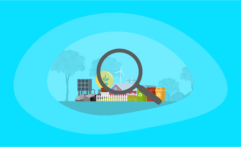13 Best Carbon Offsets for Individuals (Complete 2024 List)
Impactful Ninja is reader-supported. When you buy through links on our site, we may earn an affiliate commission.
Learn more
Learn more
.
Hey fellow impactful ninja ? You may have noticed that Impactful Ninja is all about providing helpful information to make a positive impact on the world and society. And that we love to link back to where we found all the information for each of our posts. Most of these links are informational-based for you to check out their primary sources with one click. But some of these links are so-called "affiliate links" to products that we recommend. First and foremost, because we believe that they add value to you. For example, when we wrote a post about the environmental impact of long showers, we came across an EPA recommendation to use WaterSense showerheads. So we linked to where you can find them. Or, for many of our posts, we also link to our favorite books on that topic so that you can get a much more holistic overview than one single blog post could provide. And when there is an affiliate program for these products, we sign up for it. For example, as Amazon Associates, we earn from qualifying purchases. First, and most importantly, we still only recommend products that we believe add value for you. When you buy something through one of our affiliate links, we may earn a small commission - but at no additional costs to you. And when you buy something through a link that is not an affiliate link, we won’t receive any commission but we’ll still be happy to have helped you. When we find products that we believe add value to you and the seller has an affiliate program, we sign up for it. When you buy something through one of our affiliate links, we may earn a small commission (at no extra costs to you). And at this point in time, all money is reinvested in sharing the most helpful content with you. This includes all operating costs for running this site and the content creation itself. You may have noticed by the way Impactful Ninja is operated that money is not the driving factor behind it. It is a passion project of mine and I love to share helpful information with you to make a positive impact on the world and society. However, it's a project in that I invest a lot of time and also quite some money. Eventually, my dream is to one day turn this passion project into my full-time job and provide even more helpful information. But that's still a long time to go. Stay impactful,Affiliate Disclosure
Why do we add these product links?
What do these affiliate links mean for you?
What do these affiliate links mean for us?
What does this mean for me personally?
![]()
Carbon offsetting is one method that can reduce the 35 billion tons of CO2 we pump into our atmosphere every year. But if you search for organizations that offer carbon offsets, you might find it hard to compare these with their many different options at many different price points. So, we had to ask: What are the best carbon offsets for individuals?
The best organizations for individual carbon offsets in terms of overall impact are Terrapass, GoClimate, Carbonfund, myclimate, and EcoCRED. Climeworks is by far the most effective but also the most expensive carbon offset option.
Keep reading to learn more about the best carbon offsets for individuals, how these carbon offset projects work, what their respective offsetting costs are, and what your best way would be to offset your carbon emissions. At the end of the article, we’ll also share with you what the biggest carbon offsetting limitations are and why reducing your carbon footprint is more effective than offsetting it.
Here’s What All the Best Carbon Offsets for Individuals Have in Common
Carbon offsets are reductions in carbon emissions that are used to compensate for carbon emissions occurring elsewhere. They are measured in tons of CO2 equivalents and are bought and sold through international brokers, online retailers, and trading platforms on what is known as the global carbon offset market.
“Carbon Offset: a way for a company or person to reduce the level of carbon dioxide for which they are responsible by paying money to a company that works to reduce the total amount produced in the world, for example by planting trees”
Oxford Dictionary
When you purchase carbon offsets, it’s important that they actually make a difference in total carbon emissions. To achieve that, the following are key criteria:
- Carbon offset projects have to be effective (different projects have different effectiveness rates)
- Carbon offset projects have to be additional
- Carbon offset projects have to be permanent
- The claims from carbon offset projects have to be verifiable
(For a full overview, check out our guide on how to choose carbon offset projects that actually make a difference.)
These Are the Best Carbon Offsets for Individuals in 2024
Below are our favorite carbon offsets for individuals (you can click on their link to directly jump to their section in this article):
| Carbon Offsets for Individuals | Quick Facts |
| Climeworks | About: Purchases support the practice of direct CO2 removal, where specialized machines remove CO2 directly from the air and store it in rock formations underground. Costs: $1,200 per 1,000kg of CO2 |
| Terrapass | About: Purchases support farm power, landfill gas capture, clean energy from wind power, and abandoned coal mine methane capture carbon offset projects. Costs: $16.51-$17.63 per 1,000kg of CO2 |
| GoClimate | About: Purchases support a water filter project in Indonesia, a geothermal energy project in Sumatra, and a landfill gas recovery project in Colombia. Costs: $17 per 1,000kg of CO2 |
| Carbonfund | About: Purchases support energy efficiency, forestry, and renewable energy carbon offset projects globally. Costs: $16.25-$17.16 per 1,000kg of CO2 |
| myclimate | About: Purchases support energy efficiency, forestry, waste management, and renewable energy carbon offset projects. Costs: $23-$30 per 1,000kg of CO2 |
| EcoCRED | About: Carbon offset purchases support forest preservation, wildlife habitat enhancement, wind energy, waste-to-power generation, and energy efficiency in schools in the US. Costs: $8-$15 per 1,000kg of CO2 |
| Co2nsensus | About: Purchases support offset projects involving reforestation, wind energy, energy efficiency, landfill gas, biomass, and hydropower. Costs: Pricing varies depending on the details of your offset and the offset project you select. |
| Ecologi | About: Purchases support forest restoration, renewable energy, clean cookstoves, and clean drinking water offset projects. A certain number of trees are also planted with every offset purchase. Costs: $6.04 per 1,000kg of CO2 |
| Wren | About: Purchases support biochar, tree planting, mineral weathering, clean cookstoves, and tech-enabled Amazon Rainforest protection projects. Costs: $19.80 per 1,000kg of CO2 |
| Reforest’Action | About: Carbon offset purchases support reforestation projects on 5 continents. Costs: $19.30 per 1,000kg of CO2 |
| Cool Effect | About: Purchases support avoided nature loss (forestry, tree planting, grasslands), methane capture, and clean cookstoves carbon offset projects. Costs: $8.79-$21.97 per 1,000kg of CO2 |
| CarbonClick | About: Purchases are automatically sourced from a number of projects, depending on your geographical location. After fees, 50% is allocated to local flagship forest regeneration or conservation projects, and 50% goes towards high-impact, international clean energy projects. Costs: $8-$20 per 1,000kg of CO2 |
| Sustainable Travel International | About: Purchases support forestry, clean and efficient energy, blue carbon (carbon sequestration), and community-based carbon offset projects. Costs: $12.36 per 1,000kg of CO2 |
Climeworks: The Leader in Direct CO2 Removal

Climeworks, a DAC company in Zurich, Switzerland, is the leader in the CO2 removal game. It was founded in 2009 by engineering university students Jan and Christoph, who were shocked at the melting glaciers in the Swiss Alps. Climeworks’ mission is to inspire one billion people to remove CO2 from the air and reverse climate change.
“Let’s reverse climate change”
Climeworks
Project overview: The Climeworks specialized machines take CO2 from the air, mix it with water, and pump it deep underground. Through the process of natural mineralization, the captured CO2 is turned to stone. Since its inception in 2017, Climeworks has built 15 DAC machines and switched on the world’s first large-scale plant back in 2021. For every 100 tons of CO2 captured from the air, 90 tons are permanently removed, and only up to 10 tons are re-emitted by the DAC machines.
Carbon offset costs: Climeworks has 2 options for individuals looking to offset their carbon footprint.
- Monthly Subscription: $1.20 per 1kg of CO2 removed to remove either 30, 50, or 100kg of CO2 per month.
- Gifts: $1.20 per 1kg of CO2 removed to gift CO2 in increments of 25, 45, or 85 kg.
How to get your carbon offsets: Climeworks offers the standard 3 monthly subscriptions and also provides a slider further down the page to choose a different monthly amount. Lastly, there is a “Buy a Gift” option at the bottom of the webpage for individual purchases that can be customized.
Terrapass: Multiple Options to Offset Your Individual CO2 Emissions
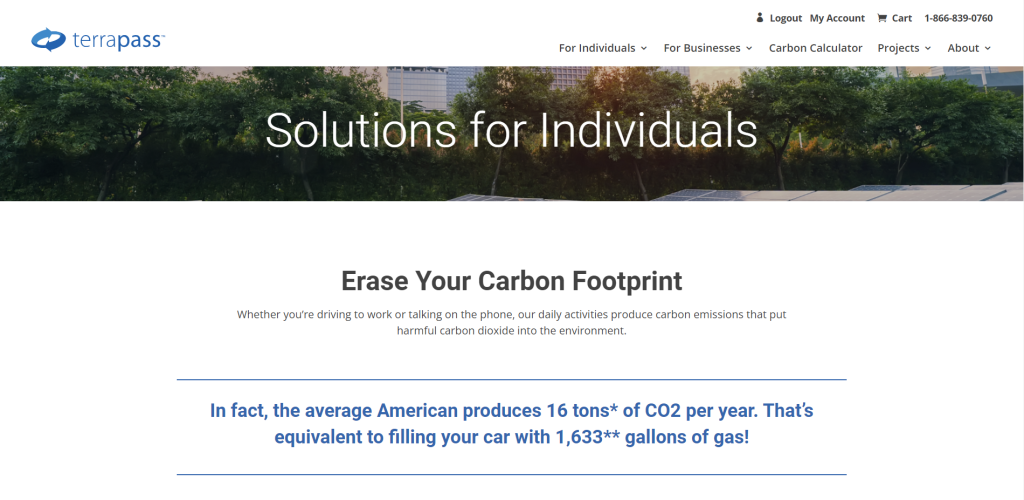
Terrapass is an organization that has been providing carbon offsets to individuals and businesses since 2004. In 2020, Terrapass customers offset roughly the same amount of carbon as planting 7 million trees. Their mission is to fight climate change by reducing as many carbon emissions as possible via the use of education, online tools, carbon offsets, and renewable energy.
“Restore the balance”
Terrapass
Carbon offset overview: Terrapass has many options for individuals looking to offset their carbon footprint. They offer a carbon balanced living plan (monthly subscription), personal offsets, flight offsets, an ecotourist bundle, and a gift of Terrapass. Purchases help fund carbon offset projects including farm power, landfill gas capture, clean energy from wind power, and abandoned coal mine methane capture.
Carbon offset effectiveness: Terrapass uses the Verified Carbon Standard, Gold Standard, American Carbon Registry, and the Climate Action Reserve to help ensure transparency and quality in the creation, quantification, and verification of offset projects.
Carbon offset costs: Terrapass has 6 options for individuals looking to offset their carbon footprint.
- Carbon Balanced Living plan: Starts at $8.34/month and factors in the number of people in your household, the number of cars you own, and how many flights you take annually.
- Flight Carbon Offsets: $17.63 per 1,000kg of CO2 offset.
- EcoTourist Bundle: $64 and includes 8,000 lbs of carbon offsets and a digital certificate. It is equivalent to 4 average flights of 4 hours or 8,600 miles traveled by car. This works out to $17.63 per 1,000kg of CO2 offset.
- Gift of Terrapass: $17.63 per 1,000kg of CO2 offset. It includes a certificate and an e-card.
How to get your carbon offsets: Visit the Terrapass website to purchase your carbon balanced living plan, personal offsets, flight offsets, ecotourist bundle, or gift of Terrapass offsets.
GoClimate: Fighting Climate Change
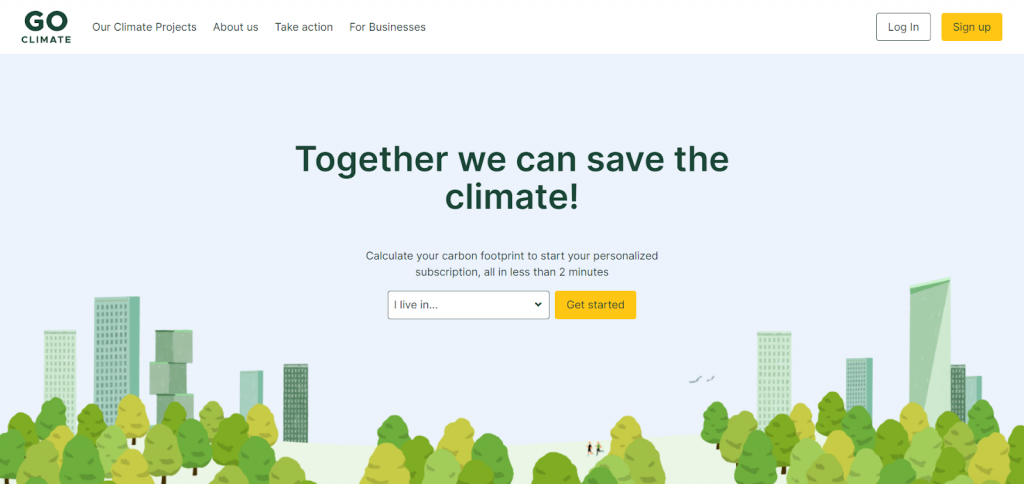
GoClimate is a social enterprise founded in 2017 with the mission of slowing climate change. They calculate your emissions, support you in reducing them, and offer a subscription service for contributing to certified climate projects. Since their inception they have contributed to the avoidance of over 733 thousand tonnes (808 thousand tons) of CO2.
“Together we can save the climate!”
GoClimate
Carbon offset overview: GoClimate provides monthly subscriptions, flight offsets, and gift cards for individuals to purchase. They also have a travel emissions calculator. Purchases currently support a water filter project in Indonesia, a geothermal energy project in Sumatra, and a landfill gas recovery project in Colombia. Previously, GoClimate has supported other renewable energy, cookstoves, and methane recovery projects in Chile, China, India, Aruba, Brazil, Turkey, Bulgaria, and Rwanda.
Carbon offset effectiveness: GoClimate uses the Gold Standard to help ensure transparency and quality in the creation, quantification, and verification of offset projects.
Carbon offset costs: GoClimate offers 3 options for individuals looking to offset their carbon footprint.
- Monthly Subscriptions: $16.99 per 1,000kg of CO2 offset.
- Flight Offsets: Approximately $17 per 1,000kg of CO2 offset.
- Gift Cards: There are 4 options that offset either 1, 3, 6, or 12 months of CO2 emissions at a cost of approximately $16.99 per 1,000kg of CO2 offset.
How to get your carbon offsets: Visit GoClimate’s website to view their monthly subscriptions, flight offsets, and gift card options.
Carbonfund: Go Carbon Neutral
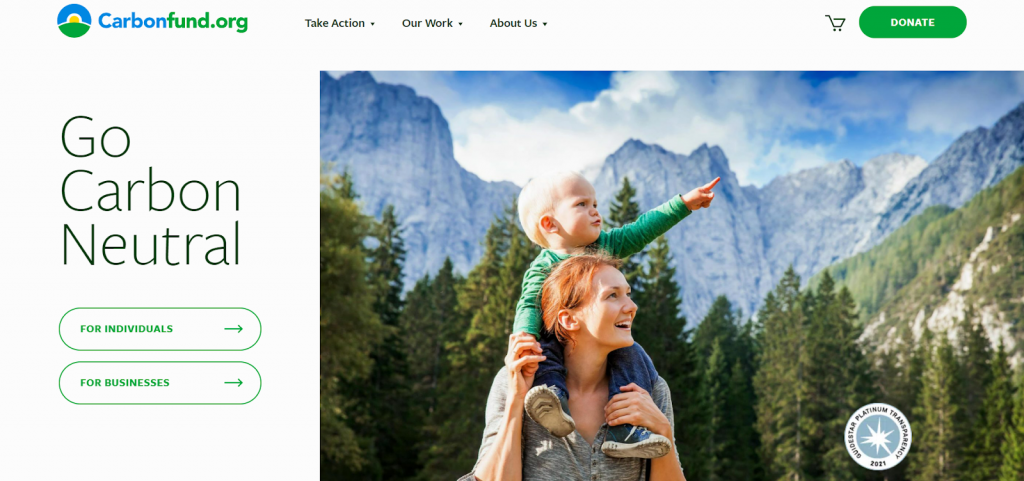
Carbonfund is a nonprofit organization founded in 2003 by current President Eric Carlson and is based in New York, United States of America. Their mission is to make it easy for any individual, business, or organization to reduce & offset their climate impact and hasten the transition to a clean energy future.
“Reduce what you can, offset what you can’t”
Carbonfund
Project overview: Individuals can join the fight against climate change by offsetting their carbon footprint, planting trees, or making a donation. Carbonfund supports third-party validated and verified energy efficiency, forestry, and renewable energy carbon offset projects globally. To date, they have supported 240 projects in 28 countries.
Carbon offset costs: Carbonfund offers 4 options for individuals looking to offset their carbon footprint.
- Individuals offsets: Approximately $17.16 per 1,000kg for lifestyle, vehicle, air travel, home, events/gifts, and water carbon offsets.
- Gifts: $16.25 per 1,000 kg of CO2 offset to offset either 2,000 or 10,000 kg (2.20 or 11.02 tons) of CO2.
- Plant Trees: $1 per tree planted in increments of 10, 25, 50, or 100.
- Donate: A minimum donation of $5 per year.
How to get your carbon offsets: You can join the fight against climate change by offsetting your carbon footprint, planting trees, or by making a donation. On their website, you can purchase customized offsets based on your lifestyle, vehicles, air travel, homes, events/gifts, water usage. And you can also support their tree planting efforts or purchase carbon offset gifts.
myclimate: Shaping the Future
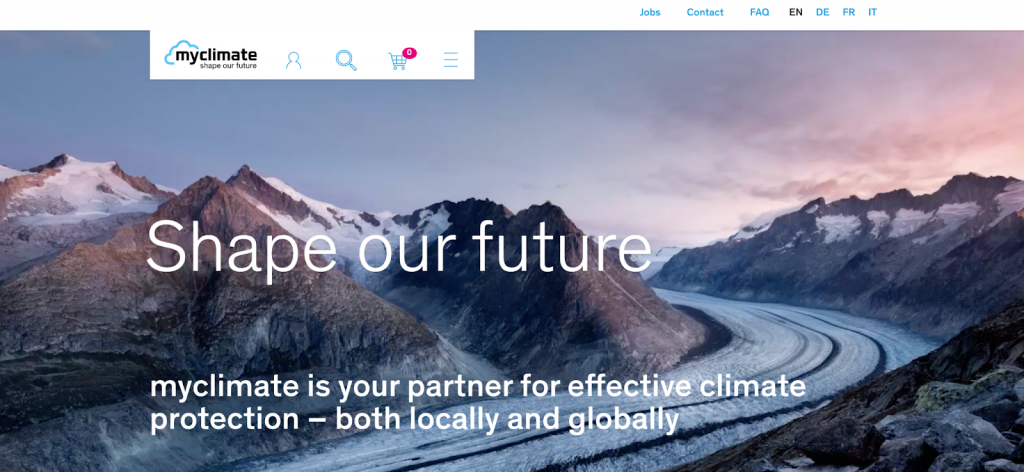
myclimate is an international, Swiss-based initiative that is one of the world’s leaders in voluntary carbon compensation measures. They work with small, medium, and large companies, public administrations, non-profit organizations, and private individuals to provide high-quality projects with quantifiable climate protection. Their mission is to be a partner for global and local climate protection and to shape the future of the world through advisory services and educational programs.
“myclimate is your partner for effective climate protection – locally and globally”
myclimate
Carbon offset overview: myclimate provides individual carbon offsets for flights, cars, cruises, events, and your household. You can also contribute directly to their projects, enroll in a subscription, or make a donation. Purchases fund offset projects including energy efficiency, forestry, waste management, renewable energy. Some examples include efficient cookstoves in the Himalayas, forest management in Switzerland, and hydropower in Vietnam. They currently have 144 voluntary carbon offset projects in 41 countries.
Carbon offset effectiveness: myclimate projects contribute to the UN’s Sustainable Development Goals and are certified according to either the Gold Standard, VCS, or Plan Vivo.
Carbon offset costs: myclimate offers 3 options for individuals looking to offset their carbon footprint.
- Individual offsets: Approximately $30 per 1,000kg of CO2 offset
- Monthly Subscription: The monthly, quarterly, half-yearly, and annual subscriptions cost approximately $23 per 1,000kg of CO2.
- Donate: A fixed rate of $30 per 1,000kg of CO2 offset.
How to get your carbon offsets: Visit their website to offset your emissions from flights, cars, cruises, events, or your household. You can also enroll in a subscription or make a donation to myclimate’s mission by either contributing a certain dollar amount or offsetting a certain number of kg of CO2.
EcoCRED: Achieving a Carbon-Neutral Life
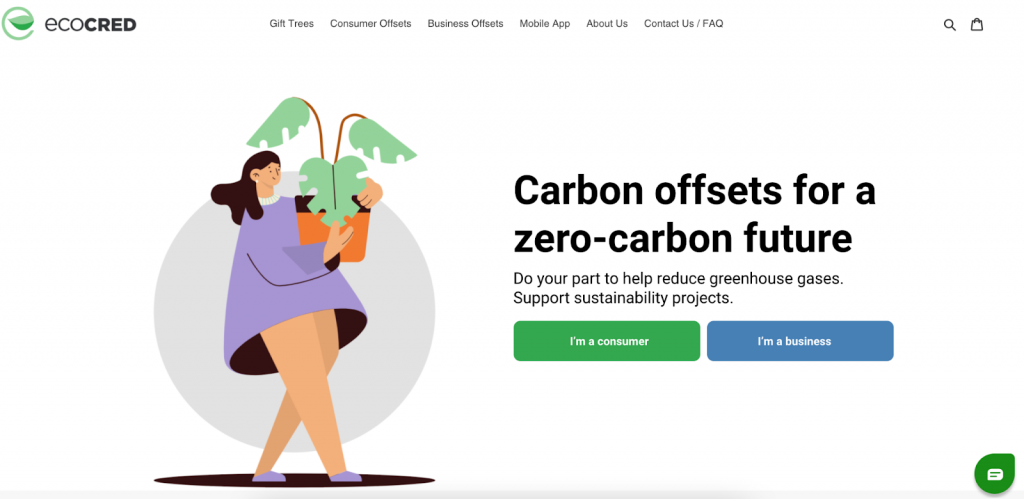
EcoCRED is a sustainability platform backed by Facedrive Inc., a service offering socially-responsible services to local communities. So far, they have 60 thousand users that have collectively reduced over 4 million lbs (18 million kg) of CO2 emissions. Their mission is to make the journey to being more sustainable easier.
“Carbon offsets for a zero-carbon future”
EcoCRED
Carbon offset overview: EcoCRED has an individual carbon offset package as well as various consumer offsets based on certain lifestyles. Purchases support projects in the US involving forest preservation, wildlife habitat enhancement, wind energy, waste to power generation, and energy efficiency in schools.
Carbon offset effectiveness: EcoCRED carbon offsets are certified by third-party organizations, the Verified Carbon Standard, the American Carbon Registry, and the Climate Action Reserve.
Carbon offset costs: EcoCred offers a variety of options for individuals looking to offset their carbon footprint.
- Individual Package: Can be purchased one-time or as a monthly subscription for approximately $30 per month to offset 3,000kg per year. This comes out to $10 per 1,000kg of CO2 offset.
- Consumer Offsets: Can be purchased one-time or as a monthly subscription for approximately $8-$15 per 1,000kg of CO2 offset.
- Plant Trees: Every $1 plants 1 tree
- Crow Lake Wind Project CO2 Offset: Costs $8 per 1,000kg of CO2. Crow Lake Wind is the largest wind project in the US with 108 wind turbines.
- Doe Mountain Project CO2 Offset: Costs $12 per 1,000kg of CO2 offset. This project is located in Tennessee, US, and includes over 8,000 acres of mixed hardwoods.
- Green Campus Carbon Offset: Costs $12 per 1,000kg of CO2 offset. This project was created to contribute to a cleaner energy future while providing research and educational opportunities for faculty, students, and staff.
- Meat Lovers Offset: Costs $2.50 to offset a month’s worth of meat consumption
- Dairy Devotee Offset: Costs $2.50 per 159kg (350lbs) of CO2 and lowers the carbon impact of your dairy intake for a month’s worth of dairy products
- EcoFlyer Offset: Costs $1.50 per 113kg (250lbs) of CO2 offset for each hour of flight time
How to get your carbon offsets: Visit EcoCRED’s individual carbon offset package or consumer carbon offset webpage to view your various options.
Co2nsensus: A Climate-Tech Company
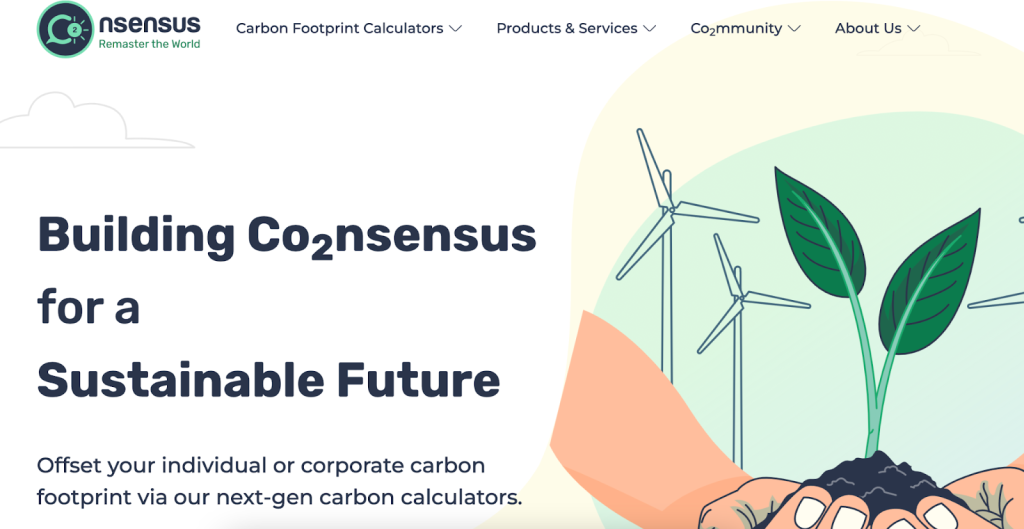
Co2nsensus was founded in 2019 by Bekir Cetin as a climate-tech company focused on helping individuals and businesses neutralize their carbon footprint. Today, they provide various carbon footprint calculators, carbon offsets for individuals, carbon management software, and a carbon-neutral e-delivery system for e-commerce.
“Building Co2nsensus for a Sustainable Future”
Co2nsensus
Project overview: Co2nsensus has personal carbon calculators for flights, travel, shipping, households, events, and accommodations. They also provide the option to purchase a direct carbon offset. Purchases support carbon offset projects involving reforestation, wind energy, energy efficiency, landfill gas, biomass, and hydropower. Example projects include improved cookstoves in Kenya, hydroelectric power in Turkey, and reforestation in Uruguay.
Carbon offset effectiveness: Co2nsensus’ carbon offset projects are verified by the Gold Standard and Verra and contribute to UN Sustainable Development Goals.
Carbon offset costs: Pricing varies depending on the the type of offset and offset project.
How to get your carbon offsets: You can visit their website to use their personal carbon footprint calculator.
Ecologi: Where Carbon Reduction Partners with Tree Planting
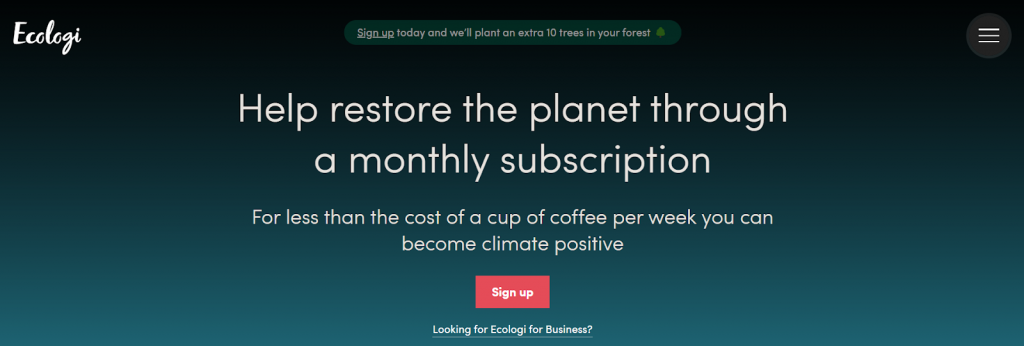
Ecologi was founded in 2019 in Bristol, United Kingdom when CEO and cofounder Elliot Coad was driving to work and thought, “How much climate action could I fund with the money for a coffee?” Their mission is to enable everyday people to tackle the current climate crisis.
“For less than the cost of a cup of coffee per week you can become climate positive”
Ecologi
Project overview: Ecologi offers a personal carbon offset plan in the form of a monthly subscription. Purchases support projects including, but not limited to, forest restoration, renewable energy, clean cookstoves, and clean drinking water. When you purchase carbon offsets through Ecologi, trees are planted as a bonus, because it takes years for trees to mature and sequester carbon in large quantities. Ecologi has tree planting partners who are able to responsibly plant millions of trees a month on their behalf. These partners include Eden Reforestation Projects, One Tree Planted, and Trees for the Future, all of which are included in our list of the Best Charities for Planting Trees.
Carbon offset costs: Ecologi has a personal offset plan where you choose how many trees get planted (12, 24, or 48) for a price ($10.50, $21, or $42 per month). It costs approximately $6.04 per 1,000 kg of CO2 offset.
How to get your carbon offsets: Visit their website to select your personal plan. And if you scroll further down you can plant 1 extra tree in the United States for only $1.20 per month. Ecologi even has an interactive google sheet where you can check when, where, and how many trees are planted through their platform.
Wren: Your All-In-One Climate Subscription
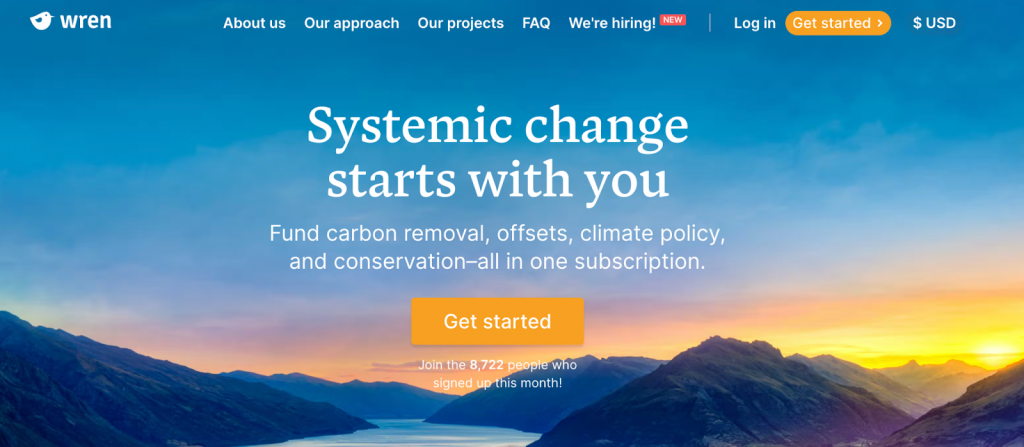
Wren is a climate conscious company formulated to be your on-ramp to climate action. To date they have offset over 160 thousand tons of CO2 in 4 countries.Their mission is to help reverse the climate crisis.
“Climate change is the largest crisis humanity has ever faced. But we can fix it.”
Wren
Carbon offset overview: Wren has a carbon footprint calculator that takes into account your location, diet, transportation, energy usage, clothes, and pets to calculate your footprint in tons of CO2 per year. Based on this information they calculate 3 different carbon offset subscriptions. They also have the option to give a climate-positive gift, which is calculated in the same manner as above. Lastly, there is also an option to purchase a lifetime gift, which offsets the entire lifetime carbon emissions of a person. Purchases support biochar in California, tree planting in Kenya, mineral weathering in Scotland, clean cookstoves in Uganda, and tech-enabled Amazon Rainforest protection projects in Peru.
Carbon offset effectiveness: Wren’s carbon offsets are permanent, additional, only counted once, and based on peer-reviewed science.
Carbon offset costs: The 3 monthly subscription options, climate-positive gift, and lifetime gift all cost approximately $19.80 per 1,000kg of CO2 offset. You can also choose the custom plan option and enter any monetary amount.
How to get your carbon offsets: Visit Wren’s carbon calculator webpage to enter the recipients’ information and purchase your monthly subscription or gifts.
Reforest’Action: Tackling Deforestation on a Global Level
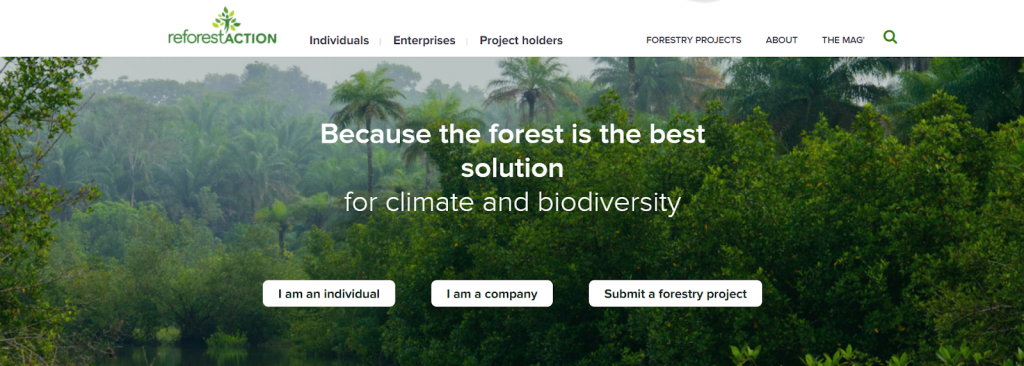
Reforest’Action is a French crowdplanting company founded in 2010 by Stéphane Hallaire. To date, they have financed more than 20 million trees in 40 different countries. Their mission is to preserve, restore, and create forests globally so that we may continue to reap the environmental, social, and economic benefits for many years to come.
“Because the forest is the best solution for climate and biodiversity”
Reforest’Action
Project overview: Reforest’Action allows you to plant trees, gift trees, or subscribe to the forest via a monthly commitment. You can purchase carbon offsets directly after using their carbon footprint calculator, which takes into account your household, transportation, and consumption. Purchases support the restoration and development of tomorrow’s carbon sinks. Reforest’Action currently has active reforestation projects in Europe, North America, South America, Africa, Asia, and Oceania. 1 carbon credit is equal to 907 kg (1 ton) of CO2 through Reforest’Action, and you can either purchase offsets or plant trees to support specific projects.
Carbon offset costs: Reforest’Action has 3 options for individuals looking to offset their carbon footprint.
- Subscribe to the Forest: $15 per month and plants 5 trees while offsetting 750kg of CO2. This works out to approximately $20 per 1,000kg of CO2 offset.
- Direct Carbon Offsets: Approximately $19.30 per 1,000kg of CO2 offset.
- Plant or Gift Trees: $3.30 per tree.
How to get your carbon offsets: You can purchase carbon offsets by visiting their carbon footprint calculator, where you can enter further information about your transportation, home, and consumption. Reforest’Action also offers the option to plant trees, offer trees, or subscribe monthly.
Cool Effect: Giving Like the Planet Depends On It
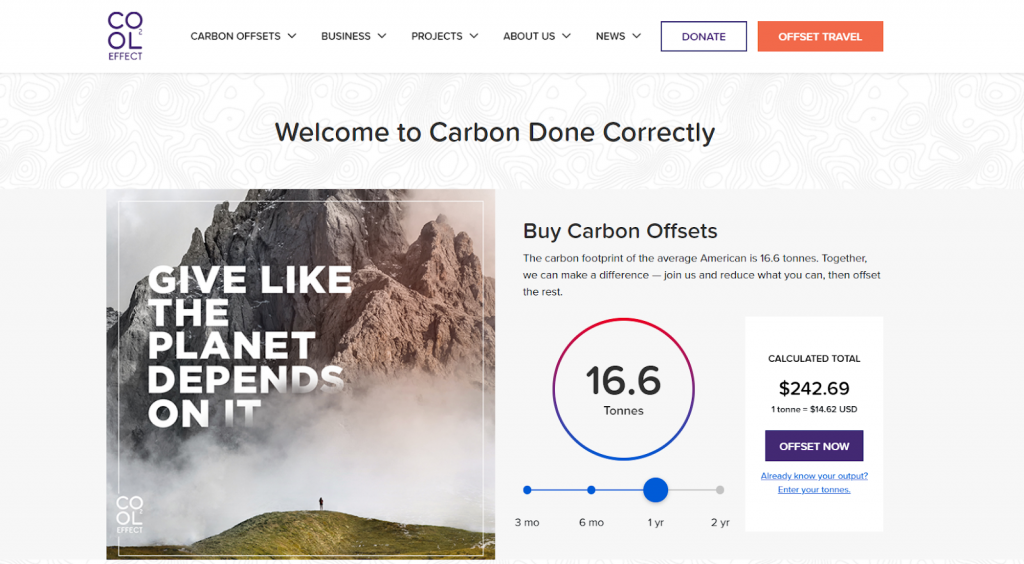
Cool Effect began in 1998 with a small, clean-burning cookstoves project in Honduras and has since grown to represent a platform with 15+ global projects and a community of 500,000+. Their mission is to give people the power and confidence to band together and reduce the carbon pollution that causes climate change.
“Carbon done correctly”
Cool Effect
Project overview: Cool Effect offers carbon offsets for travel and flights. Purchasing offsets funds projects involving avoided nature loss (forestry, tree planting, grasslands), methane capture, and clean cookstoves. These projects are located in the United States (Montana, Oregon, Tennessee), India, China, Myanmar, Indonesia, Honduras, Kenya, and Uganda. More than 90% of each dollar you donate goes directly towards the projects, with a fee of 9.87% to cover credit charges, research, and possible registration fees.
Carbon offset costs: An individual purchase costs $14.62 per 1,000 kg of CO2 offset, and a specific project costs anywhere from $8.79 – $21.97 per 1,000 kg of CO2.
How to get your carbon offsets: If you don’t already know your carbon output, you can offset 16.6 metric tonnes, what Cool Effect has determined to be the carbon footprint of the average American, as a default option. And if you do know your carbon output, you can enter that number. They also have a webpage where you can find information about their specific carbon projects and pricing information.
CarbonClick: Meeting the Highest Standards of Social and Environmental Impact
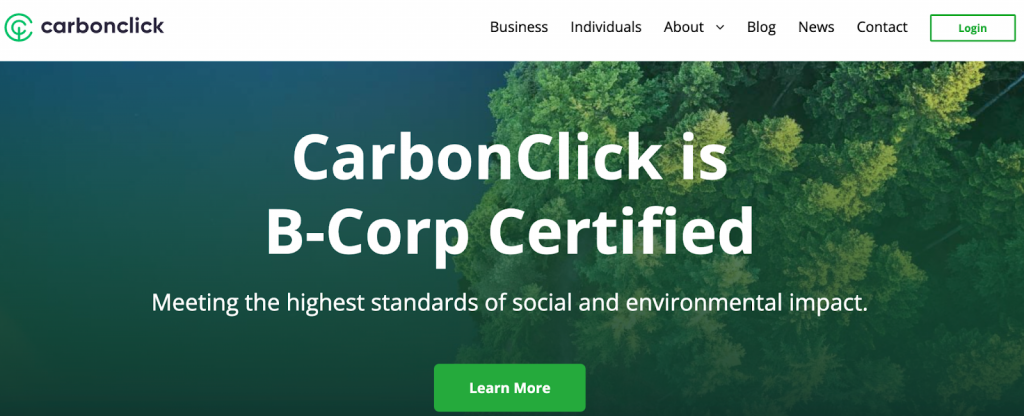
CarbonClick is a New Zealand-based environmental company that has since spread to the United States, Ireland, Malaysia, and the Philippines. Their mission is to make climate action simple and transparent for both customers and businesses, through projects that support the planet and humanity. To date, they have offset over 38 million kg of CO2 through various projects.
“We exist to reverse climate change”
CarbonClick
Carbon offset overview: CarbonClick has a unique approach to carbon offsetting. The offsets you purchase are automatically sourced from a number of projects, depending on your geographical location. After fees are deducted, 50% of the remaining amount is allocated to local flagship forest regeneration or conservation projects, and 50% goes towards high-impact, international clean energy projects. For example, if you live in the US then your money will support forestry in Alaska, wind power in South Dakota, and improved cooking practices in Nigeria.
Carbon offset effectiveness: CarbonClick offsets are additional and adhere to the UN’s Sustainable Development Goals.
Carbon offset costs: CarbonClick offers 4 monthly subscriptions which offset either 9, 15, 30, or 61 thousand kg of CO2 per year at a cost of approximately $20 per 1,000kg of CO2 offset.
How to get your carbon offsets: Visit their webpage to view their 4 monthly subscription options. You can also choose to which basket of projects you want to contribute.
Sustainable Travel International: Transforming Tourism’s Impact on Nature
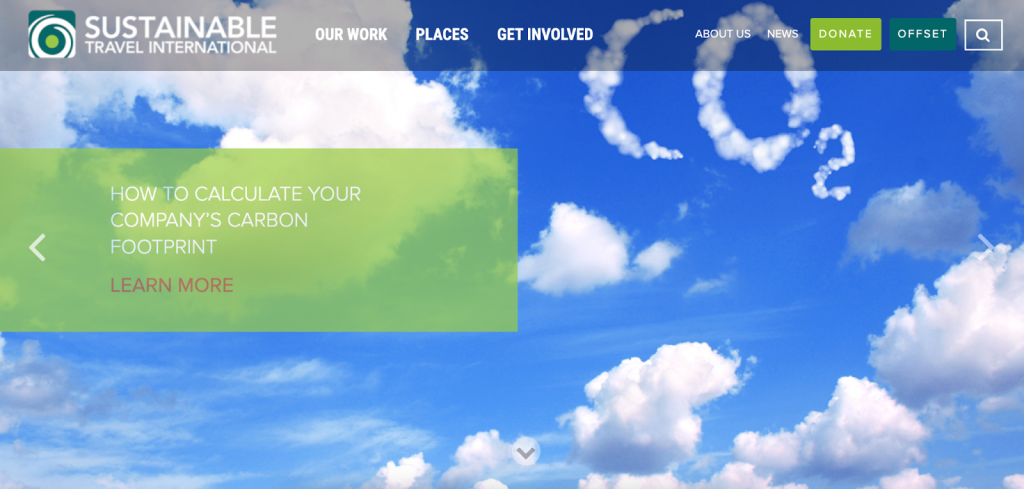
Sustainable Travel International has been charting a new course for travel and tourism since 2002. Since 2007, they have helped individuals and companies offset over 386,309 metric tons (over 386 million kg) of CO2. Their mission is to transform tourism’s impact on nature and communities by protecting and conserving this planet’s most vulnerable destinations.
“We’re dedicated to minimizing the negative impacts of tourism and maximizing its positive benefits for people, cultures, nature, and wildlife around the globe”
Sustainable Travel International
Carbon offset overview: Sustainable Travel International offers carbon offsets for flights, cars, and boats. You can also make a donation or become a member. Purchases fund projects involving forestry, clean and efficient energy, blue carbon (carbon sequestration), and community-based projects. Some examples include wind farms in Honduras, reforestation in Brazil, and water filtration in Cambodia.
Carbon offset effectiveness: Sustainable Travel International projects are third-party verified and validated to meet rigorous standards including additionality, permanence, no double-counting, and alignment with the UN’s Sustainable Development Goals.
Carbon offset costs: It costs approximately $12.36 per 1,000kg of CO2 offset with their various options.
How to get your carbon offsets: Visit their carbon offset calculator to offset your emissions based on your mode of transportation (i.e., flight, car, or boat). Or if you already know your carbon footprint, you can offset by metric tons of CO2. Alternatively, you can donate to their cause or become a member.
How to Choose Carbon Offset Projects Actually Make a Difference
The following information is a summary for you based on our full guide: “How to Buy Carbon Offsets That Actually Make a Difference”
Purchase carbon offset projects with high effectiveness rates. The offset programs in order of most to least effective are:
- Direct CO2 removal: Machines remove CO2 directly from the air. Effective at reducing emissions in the short and long-term because they are additional and permanent.
- Renewable energy: Investing in projects that build and maintain renewable energy sites globally. There is no additionality because renewables are becoming a greater share of our energy mix, with or without the help of offsets.
- Energy efficiency improvements: The creation of products or systems that use less energy than conventional systems to perform the same task. However, if products are replaced too quickly, the amount of CO2 required to produce the new product would exceed the amount of CO2 saved with the new product.
- Carbon sequestration: The long-term storage of carbon via forestry practices. Not an effective way to reduce emissions in the long-term because there is no guaranteed permanence.
If – and only if – they are both additional and permanent, carbon offsets can help reduce your overall GHG emissions to balance off your personal carbon footprint to fight climate change – at least in the short term. But they can be much more effective if they meet certain key criteria and project standards.
Here are key criteria to look for in a carbon offset program:
- A clearly defined protocol that determines which types of projects are eligible and how emission reductions will be measured
- Independent third-party verification of compliance with the protocol
- Registration of offsets in an offset registry, which tracks each credit with a unique serial number to ensure it is only used once
- Transparency in project implementation and reporting
If used correctly, carbon offsets can provide environmental, economic, and social benefits that go beyond reducing carbon emissions. They have the potential to instigate meaningful environmental change and begin to reverse some of the effects of climate change.
Carbon offset project standards assure transparency and quality in the creation, quantification, and verification of offset projects. This way you can ensure that the project is actually reducing CO2 emissions. The following are recognized carbon offset standards:
- Verified Carbon Standard (VCS): Considered the world’s leading voluntary GHG program, with 1700+ projects having removed 630+ million tons of CO2 from the atmosphere. Examples of projects include hydropower in Turkey, forest conservation in Peru, and landfill gas capture in China.
- Gold Standard: A certification that seeks to maximize every dollar of climate and development funding. It has issued 134 million carbon credits from 1700+ projects based in more than 80 different countries. Examples of projects include solar power in India, efficient cooking and heating in China, and wind power in Indonesia.
- Climate Action Reserve (CAR): The premier carbon offset registry for the North American carbon market having issued over 150 million offset credits since its inception in 2001. Examples of projects include landfill gas capture in South Carolina and forest management in California.
- American Carbon Registry (ACR): The first private voluntary GHG registry in the world. Examples of projects include ozone-depleting substances in Arkansas and methane capture from mines in Kentucky.
Choosing carbon offset projects from any of the above project standard registries helps ensure that your project is verified and that it actually reduces CO2 emissions.
What Are the Biggest Carbon Offsetting Limitations
In fact, there are 9 main carbon offsetting limitations that can make the current voluntary carbon market controversial and lead to confusion, inconsistencies, and a general distrust of the system. Have a look at the quick summary table below.
| Carbon Offsetting Limitation | Quick Facts |
| #1: You don’t reduce your own carbon footprint | When you purchase a carbon offset, you are paying someone else to cut their emissions so you don’t have to cut your own emissions. |
| #2: Carbon offsets do not work at the core issue of reducing CO2 emissions | Global warming is still occurring at an accelerated rate because offsetting CO2 emissions does not cut CO2 emissions at the source, it only mitigates emissions. |
| #3: Carbon offsetting only reduces CO2 if the projects are additional and permanent | If carbon offset projects are not additional and permanent, they can make climate change worse because they are not offsetting any carbon. |
| #4: “Poorer” countries are paid to offset carbon while the “rich” countries continue to emit | The richest of the world emit the majority of the world’s carbon. Offsets are just licenses to pollute with the benefit of aiding those in developing countries. |
| #5: Different projects have different effectiveness rates | The varying levels of effectiveness of carbon offset programs make it difficult to choose one that actually reduces emissions. The most effective offset programs are renewable energy programs, followed by energy efficiency improvements, carbon sequestration, and aviation offset programs. |
| #6: CO2 offsets are only realized at the end of project durations | If a carbon offset program is not carried out until the end, then we cannot reap the program’s benefits. For example, planting trees is a common offset program that is only effective if those planted trees are protected during their life span for the carbon benefits to be realized. |
| #7: There are not enough offsets for all CO2 emissions | We emit far more CO2 than we can offset because of carbon sink (e.g., atmosphere, forests, soil, ocean) limitations. |
| #8: Not all offset projects get realized | Of the credits for 1 billion tons of CO2 listed on registries, only about 300-400 million tons of CO2 offsets actually get realized. |
| #9: Carbon offsetting projects are often used as greenwashing | Investing in non-verified credits, not prioritizing in-house emissions reductions, and double-counting carbon credits are methods of greenwashing. Also, companies may advertise a specific program, but it may be just for public attention instead of actually reducing emissions. |
You can check out the full article here: “What Are the Biggest Carbon Offsetting Limitations? (All 9 Explained)”
Why Reducing Your Carbon Footprint Is More Effective Than Offsetting It
The main argument against carbon offsets is that they don’t really reduce overall emissions. Instead of substituting offsetting carbon emissions, we should instead cut the emissions directly at the source. Basically, if we stop emissions from getting into the atmosphere in the first place, we won’t have to worry about offsetting. But have we done this? Have we cut emissions directly at the source? The data says no.
The COVID-19 pandemic triggered the largest decrease in energy-related carbon emissions since World War II, a decrease of 2 billion tons. However, emissions rebounded quickly at the end of 2020, with levels in December ending 60 million tons higher than those in December 2019. This indicates that the earth is still warming at an accelerated rate, and not enough is being done to implement clean energy practices.
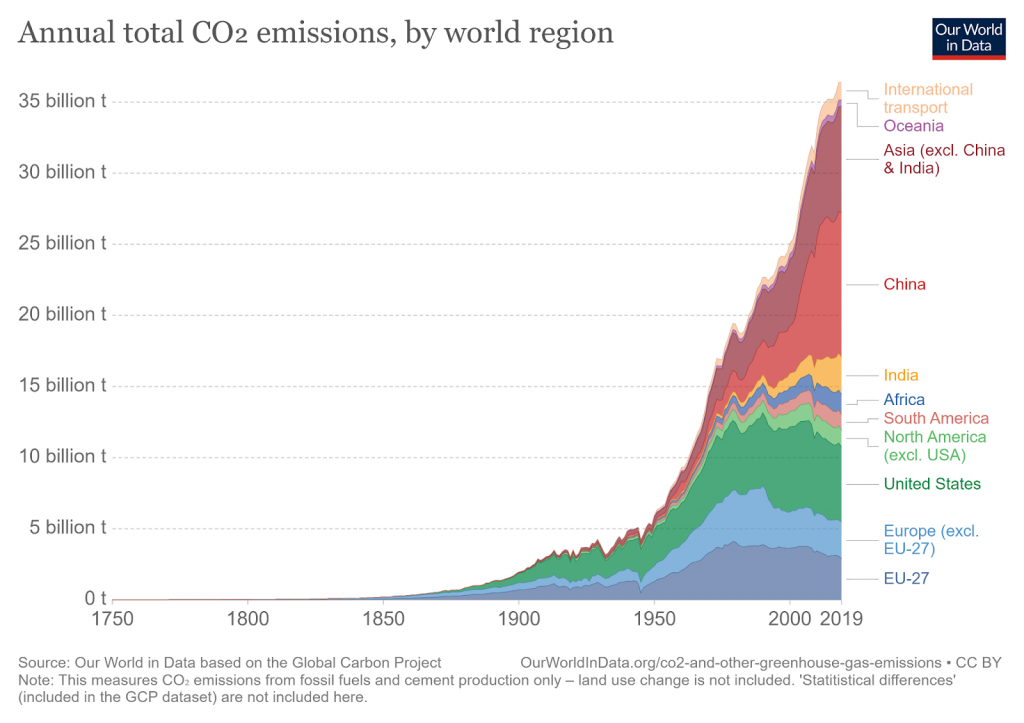
When you buy a carbon offset, you are paying someone else to cut their emissions so you don’t have to cut your own emissions. This is why offsetting alone will not be enough to reduce global carbon emissions.
Carbon offsets are a good place to start if you want to get into the carbon-emission reduction game, but in order to be effective in the long term, we must not rely on them solely. Cutting emissions from the source and then offsetting the remainder is the best way to reduce our carbon footprint and provide the highest environmental benefits. If we fail to cut emissions first, we will fill up our carbon sinks and render them unusable. Preventing carbon emissions rather than reacting once they are already emitted is the best way to reduce overall emissions.
Carbon offsets reduce GHG emissions from coal, oil, and natural gas. Reducing your consumption of these, in turn, reduces your carbon footprint, which has huge impacts on environmental, economic, and public health. A reduced carbon footprint due to lower GHG emissions can mitigate the effects of climate change, improve public health, boost the economy, and maintain plant and animal diversity.
- Climate change: Reducing your carbon footprint plays a role in mitigating the side effects of global climate change. The more we reduce the amount of GHG emissions, the more we slow the rate of temperature rise, sea-level rise, ice melting, and ocean acidification.
- Public health: Reducing GHG emissions lessens the likelihood and severity of extreme weather events, improves air and water quality, maintains biodiversity, and supports a healthy food supply.
- Economics: Reducing GHG boosts the economy, especially when it becomes economically rewarding to innovate solutions that help protect our planet, fight climate change, and are based on clean energy.
- Plant and animal diversity: Protecting biodiversity protects human health because many plants and animals are used in modern medicines
Carbon offsets have the potential to instigate meaningful environmental change, but to make the greatest impact we must understand both their benefits AND drawbacks.
You can find out all about it in our article “Can You Really Offset Your Carbon Footprint? Here Are the Facts”
Final Thoughts
Climeworks, Terrapass, GoClimate, Carbonfund, myclimate, EcoCRED, Ecologi, Wren, Reforest’Action, Cool Effect, CarbonClick, and Sustainable Travel International have the best carbon offset options for individuals looking to reduce their carbon footprint. They are third-party verified, permanent, additional, use the leading carbon offset standards, and adhere to the UN’s Sustainable Development Goals.
But for all of the good carbon offsets can instigate, they should not be seen as the only solution to climate change. They are effective at reducing CO2 in the short-term, but in the long term they fail to reduce CO2 enough. When used in conjunction with direct CO2 reduction measures, carbon offsetting can be much more effective. We should reduce our own carbon footprint as much as possible first, and only then choose the most effective carbon offsets for individuals.
Stay impactful,

Sources
- Our World in Data: Climate change and flying – what share of global CO2 emissions come from aviation?
- U.S. Environmental Protection Agency: Offsets and RECs -What’s the Difference?
- Britannica: Carbon Offset
- David Suzuki Foundation: Are carbon offsets the answer to climate-altering flights?
- Impactful Ninja: How to Buy Carbon Offsets That Actually Make a Difference (Complete 2022 Guide)
- Climeworks: Homepage
- Climeworks: Purpose
- Climeworks: Direct air capture – a technology to remove CO₂
- Climeworks: Choose your CO₂ removal plan
- Climeworks: The most sustainable gift
- Terrapass: Homepage
- Terrapass: About Terrapass
- Terrapass: Carbon Offsets for Individuals and Families
- Terrapass: Carbon Balanced Living Plan
- Terrapass: Personal Carbon Offsets
- Terrapass: Flight Carbon Offset
- Terrapass: Ecotourist Bundle
- Terrapass: Gift of Terrapass
- Verra: Verified Carbon Standard
- Gold Standard: Gold Standard Impact
- American Carbon Registry: Homepage
- Climate Action Reserve: Homepage
- GoClimate: Homepage
- GoClimate: About Us
- GoClimate: Take Action
- GoClimate: Flights
- GoClimate: Gift Cards
- GoClimate: Travel Emissions Calculator
- GoClimate: Our Climate Projects
- Carbonfund: Homepage
- Carbonfund: About Carbonfund.org
- Carbonfund: Offset Your Life
- Carbonfund: Plant Trees
- Carbonfund: Donate
- Carbonfund: Our Energy Efficiency Projects
- Carbonfund: Our Forestry/Reforestation Projects
- Carbonfund: Our Renewable Energy Projects
- Carbonfund: Carbonfund.org Foundation Project Maps
- Carbonfund: Lifestyle
- Carbonfund: Vehicle
- Carbonfund: Air Travel
- Carbonfund: Home
- Carbonfund: Events/Gifts
- Carbonfund: Water Usage
- myclimate: Homepage
- myclimate: About myclimate
- myclimate: Carbon Offset Subscriptions
- myclimate: Flight Carbon Calculator
- myclimate: Car CO2 Emissions Calculator
- myclimate: Offset Your Cruise Carbon Footprint
- myclimate: Offset your event carbon footprint
- myclimate: Offset the carbon footprint of your household
- myclimate: Donation for climate protection
- myclimate: Carbon Offset Projects
- Plan Vivo: Homepage
- myclimate: Donation for Climate Protection
- EcoCRED: Homepage
- EcoCRED: Collection Consumers
- EcoCRED: Plant Trees
- EcoCRED: Crow Lake Wind Project CO2 Offset
- EcoCRED: Doe Mountain Project CO2 Offset
- EcoCRED: Green Campus Carbon Offset
- EcoCRED: Meat Lovers Offset
- EcoCRED: Dairy Devotee Offset
- EcoCRED: EcoFlyer Offset
- EcoCRED: Carbon Offset My Family
- Co2nsensus: Homepage
- Co2nsensus: Carbon Offset Calculator | Flight Offset
- Co2nsensus: Buy Carbon Offsets
- Co2nsensus: Carbon offset projects
- Co2nsensus: Improved Cookstoves Offset Project
- Co2nsensus: Buyukduz Hydroelectric Powerplant – Turkey
- Co2nsensus: Weyerhaeuser’s Forest Plantation, Uruguay
- The Gold Standard: Homepage
- Verra: Verified Carbon Standard
- United Nations Department of Economic and Social Affairs: The 17 Goals
- Ecologi: Homepage
- Ecologi: About
- Ecologi: Reforestation and Carbon Offsetting Projects
- Eden Reforestation Projects: Homepage
- One Tree Planted: Homepage
- Trees for the Future: Homepage
- Impactful Ninja: 9 Best Charities for Reforestation
- Ecologi: Plan
- Ecologi: Ecologi Public Impact & Operations Ledger
- Wren: Homepage
- Wren: Calculate Your Footprint
- Wren: About Us
- Wren: Our Projects
- Wren: Your Carbon Footprint
- Wren: Gifts
- Reforest’Action: Homepage
- Reforest’Action: A Unique Model of Crowdplanting
- Reforest’Action: Our Mission
- Reforest’Action: Our Reforestation Projects
- Reforest’Action: I Plant Trees
- Reforest’Action: Offer a Tree
- Reforest’Action: Subscribe to the Forest!
- Reforest’Action: Calculate my Carbon Footprint
- Cool Effect: Homepage
- Cool Effect: Our History
- Cool Effect: Our Mission is to Reduce Carbon Emissions
- Cool Effect: Scientifically Verified Carbon Projects and Pricing
- Cool Effect: Our Approach
- CarbonClick: Homepage
- CarbonClick: About
- CarbonClick: Carbon Offset
- Sustainable Travel International: Homepage
- Sustainable Travel International: Carbon Offsets
- Sustainable Travel International: About Us
- Sustainable Travel International: What is Blue Carbon and Why Does it Matter?
- Sustainable Travel International: Carbon Offset Projects
- Sustainable Travel International: Carbon Project Quality Assurance
- United Nations Department of Economic and Social Affairs: The 17 Goals
- Sustainable Travel International: Calculate Your Travel Carbon Footprint
- Sustainable Travel International: Donate to Sustainable Travel International
- Sustainable Travel International: Join Now – Individual Membership
- Natural Resources Defense Council: Carbon Offsets 101
- Terrapass: Project Standards
- Verra: Verified Carbon Standard
- Verra: Tepekisla Dam & Hydropower Plant Project
- Verra: The Jaguar Amazon Redd+ Project
- Verra: Sanya Landfill Gas Power Generation Project
- Gold Standard: Gold Standard Impact
- Climate Action Reserve: About Us
- Climate Action Reserve: Registry
- Climate Action Reserve: Bluesource – Berkeley County Landfill Gas Project
- Climate Action Reserve: Buckeye Forest Project
- American Carbon Registry: Our Mission
- American Carbon Registry: Registry
- American Carbon Registry: EOS Climate ODS destruction
- American Carbon Registry: Baker Mine AMM
- Impactful Ninja: What Are the Biggest Carbon Offsetting Limitations? (All 9 Explained)
- GreenPeace: The biggest problem with carbon offsetting is that it doesn’t really work
- International Energy Agency: After steep drop in early 2020, global carbon dioxide emissions have rebounded strongly
- Our World in Data: Annual total CO2 emissions
- Impactful Ninja: What Is the Carbon Footprint of Coal Energy? A Life-Cycle Assessment
- Impactful Ninja: What Is the Carbon Footprint of Oil Energy? A Life-Cycle Assessment
- Impactful Ninja: What Is the Carbon Footprint of Natural Gas? A Life-Cycle Assessment
- Impactful Ninja: 4 Main Reasons Why Reducing Your Carbon Footprint Is Important
- National Wildlife Federation: Climate Change
- National Institute of Environmental Health Sciences: Health Impacts of Climate
- Carbon Tax Center: What’s a Carbon Tax?
- World Health Organization: Biodiversity and Health
- Impactful Ninja: Can You Really Offset Your Carbon Footprint? Here Are the Facts


